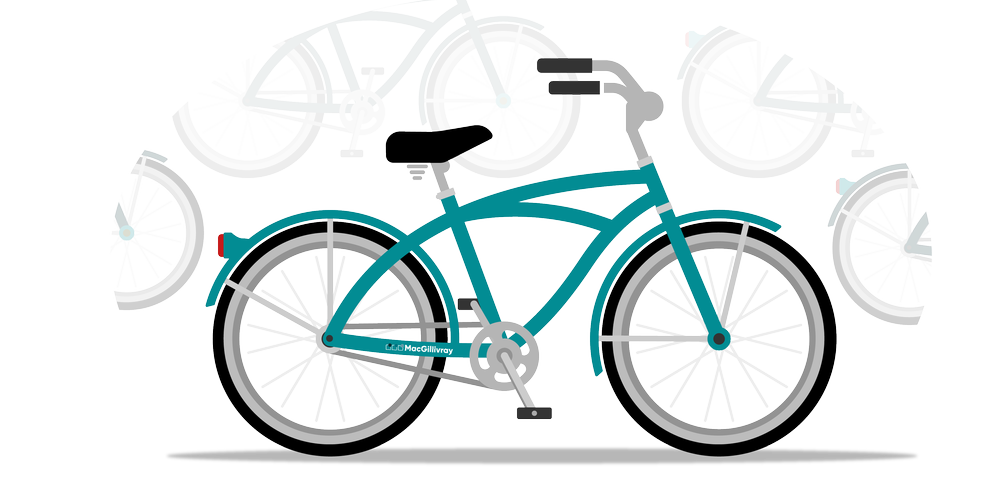




Accidents involving cyclists and vehicles can lead to serious injury
Cycling, known for its health benefits and cost-effectiveness, has become increasingly popular in Canada, including in Nova Scotia. This has led to more bicycle traffic and the creation of bike lanes in cities and small towns. However, cyclists remain vulnerable near motor vehicles, even with helmets and other protective gear. Collisions can be devastating to the cyclist. There are 74 fatal bicycle accidents per year on average.
If you’ve been injured or have lost an important one in a bike accident, MacGillivray Law’s bicycle accident lawyers are available to assist with personal injury claims.
What should I do if I’m hit by a car while biking?
After being hit by a vehicle, a cyclist may suffer from serious injuries or shock, making it challenging to gather information. Here’s what to do if you’re involved in a car accident while biking:
- Prioritize your health: Seek immediate medical attention if you are injured, as some injuries may not be immediately apparent.
- Call emergency services if needed: In Nova Scotia, the police should be called to the scene, along with any other necessary emergency services.
- Collect Information: If possible, gather information about the driver, including their name, contact information, and insurance details, as well as the make and model of the vehicle. Obtain the name and contact information of any witnesses, and take photos of the location, vehicle, bicycle, and injuries, if possible. Even if the driver is uninsured or flees the scene, you can still seek compensation.
- Gather evidence: If you can, take photos of the vehicle and bicycle, the overall scene, and any visible injuries. Note the time, location, and road conditions. If there are witnesses, get their names and contact info. These details can help establish what happened and who was at fault.
- Report the accident to police: In Nova Scotia, accidents that cause any injury or over $2,000 in property damage must be reported to law enforcement. Even for minor fender-benders, it’s wise to have a police report for an official, unbiased record of the incident.
- Consult a personal injury lawyer and contact your insurance company: After medical care, speak with an experienced bicycle accident lawyer and contact your insurance company to begin a personal injury claim.
- Be aware of time limits: In Nova Scotia, the limitation period for a bicycle accident claim is 2 years, although certain factors can alter this. Seeking legal help early can ensure you receive the compensation you deserve.
Remember, the moments following an accident are vital for establishing a record of what happened, so take these steps to protect your rights and interests.
Common cyclist injuries
Some common bicycle accident injuries include:
- Road rash
- Broken teeth
- Facial injuries, such as damage to eyes, nose, and jaw
- Traumatic brain injuries or other head injuries
- Broken bones
- Soft-tissue injuries
- Neck and back injuries
- Psychological injuries, such as Post Traumatic Stress Disorder and anxiety
After an accident, an injured cyclist may be in shock and not feel pain right away. Injuries might only appear days or weeks later. Seeing a medical provider promptly is vital to ensure that any injuries are diagnosed and treated correctly.
What are cyclist rights and responsibilities in Nova Scotia?
Cyclists, like drivers, must follow the legal obligations of the province where they are riding. Even though cyclists don’t take lessons or pass a test, they must know and follow the rules of the road to prevent accidents. Drivers should also be aware of these rules, including keeping at least one meter of space between their vehicle and cyclists.
In Nova Scotia, the law regarding bicycles is mainly found in the Motor Vehicle Act, RSNS 1989, c 293. Although bicycles are specifically excluded from the definition of ‘motor vehicle’ in the Act, several sections apply to cyclists:
- Section 85: Cyclists on the road must follow the same laws as motor vehicles, where applicable.
- Section 170A: Cyclists must wear a helmet that meets regulations.
- Section 171(2): Bicycles cannot be ridden on sidewalks.
- Section 174(6): Bicycles must have front lights visible from 100 meters and rear red lights or reflectors visible from 60 meters, especially in reduced visibility conditions.
- Section 183(5): Bicycles must have a working bell or horn.
These rules are intended to keep cyclists and motorists safe. In fact, approximately 1 in 3 cycling fatalities occur where road safety rules have not been followed. Around the same proportion of cyclist fatalities involved a rider not wearing a helmet.
By adhering to the provisions set out above, both motorists and cyclists can help minimize collisions and injuries, making the roads safer for everyone.
How long do I have to file a personal injury claim for my bicycle accident?
In general, the legal limitation period for filing a motor vehicle accident claim is two years from the date of the accident in Nova Scotia, although there are exceptions. There are other time limits that apply to no-fault claims under Section B in Nova Scotia. At MacGillivray Law, we typically file a lawsuit against the at-fault driver one year after the date of the accident, or once your injuries have healed or the extent of your injuries can be accurately assessed.
It is important to contact a lawyer as soon as possible after a bicycle accident occurs. It is your lawyer’s job to build a strong case for you, which may include preserving evidence from the scene of the accident, gathering witness statements, and consulting with accident reconstruction specialists. The sooner you engage a lawyer, the sooner they can begin their work gathering time-sensitive evidence. Contacting a lawyer promptly also helps ensure that all timelines are met in the litigation process so that your claim can be pursued successfully.
How do I prove who is at fault if I was hit by a car when I’m biking?
In most vehicle accidents, the injured person’s lawyer must prove that the other driver’s negligence caused their injuries. But in Nova Scotia, the situation is unique when a cyclist is struck by a vehicle. In this case, the burden is reversed; the driver must prove they were not at fault. This shift recognizes the vulnerability of cyclists and stresses the need to follow traffic laws.
In legal terms, this burden of proof is judged on a ‘balance of probabilities.’ The driver must show it’s more likely they were not responsible. If they meet this standard, the court then decides if the cyclist was fully or partially at fault for the accident.
If the driver is even partially at fault, they must pay some damages to the injured cyclist for the harm caused.
What happens when a cyclist is partially responsible for a car accident?
When the actions or inactions of the cyclist played a contributing role in the accident, sometimes fault for the accident is shared between the motorist and the cyclist. This is called contributory negligence.
If a cyclist is partly responsible, their compensation is reduced by the percentage of their fault. For example, if they’re awarded $100,000 but are found 25% at fault, they’ll receive $75,000. In rare cases, a cyclist might be found entirely at fault, if their actions were such that the driver couldn’t have avoided the accident.
What might cause a cyclist to share the blame? Factors include:
- Failure to use bike lanes
- Ignoring traffic signs and signals
- Riding against traffic or on the sidewalk
- Impaired, aggressive, or reckless riding
- Insufficient protective gear
- Wearing headphones while riding
In these scenarios, the cyclist’s compensation would be adjusted according to their responsibility for the accident.
Contributory negligence doesn’t mean the victim is left without compensation. Rather, it reduces the amount awarded. A personal injury lawyer can help by collecting the necessary information and building a case to maximize the victim’s entitled damages. Even if some fault lies with the injured party, legal assistance can help in obtaining significant compensation. Book a free consultation to learn more.
Are there Nova Scotia court cases about bicycle accident injuries?
Yes, there are published court decisions in Nova Scotia where cyclists received compensation through the Courts. Keep in mind that each case is unique, and no two situations will be identical. If you’ve been injured in a bicycle accident, it’s important to get input from a lawyer.
In Birch v. Eastern Dairyfoods Co-Operative Ltd, [1986] NSJ No 50, a 46-year-old man was bicycling home in Sydney, Nova Scotia, when a truck owned by Eastern Dairyfoods Co-Operative turned right into a driveway without signaling. The cyclist couldn’t avoid the truck due to parked cars and was hit and carried 30 feet. The truck’s front wheel ended up on his back, and the driver backed off him. The cyclist was taken to the hospital with bruises, lacerations, black eyes, fractured ribs, a lung contusion, and internal bleeding.
The Court found the truck driver should have been more cautious when turning but also noted the cyclist could have been more attentive. Liability was split 75% for the driver and 25% for the cyclist.
In Kulig v. Clayton, 2012 NSSC 252, the 58-year-old cyclist, Ms. Kulig, was travelling as a part of a cycling tour of Nova Scotia, through Yarmouth. She was cycling in the same direction as Mr. Clayton’s truck on Main Street. When she tried to enter a T-intersection, the truck turned right in front of her, causing a collision. She was thrown to the ground and injured.
The Court determined Mr. Clayton did not pay adequate attention to traffic when making his turn, especially as he had seen many cyclists passing his vehicle before the collision. However, Ms. Kulig did not adequately assess the safety of crossing the intersection. The Court found the Mr. Clayton 75% responsible and Ms. Kulig 25% liable for the accident.
In Langille v. DG Wolfe Enterprises Ltd, 1987 CanLII 9387 (NSCA), Ms. Langille was bicycling on a sidewalk in Halifax, Nova Scotia, when the driver of a company-owned vehicle, made a right turn across the sidewalk, intending to take a shortcut. This resulted in a collision with Ms. Langille’s bicycle.
Initially, the trial judge found the cyclist entirely at fault, citing the Motor Vehicle Act, which prohibits bicycling on the sidewalk. However, the Court of Appeal decided both parties were negligent. Ms. Langille was found responsible for riding on the sidewalk and at an excessive speed, while the driver was faulted for failing to keep a proper lookout and for not paying full attention while turning across a sidewalk. The Court apportioned liability at 75% to the driver and 25% to the cyclist.
The above cases demonstrate that determining fault in injury claims is not always black and white. Consulting with a personal injury law firm following a bicycle accident can help you access the compensation you deserve.
How can cyclists hurt in an accident in Nova Scotia be compensated?
If a cyclist is injured in a car accident, financial compensation through insurance is available. This can cover different types of damages, including pain and suffering, lost wages, reduced ability to do household chores, future medical care, and out-of-pocket expenses like medical costs. Certain benefits, such as income replacement and some medical coverage, are available regardless of fault through Section B insurance.
Unlike typical car accidents involving drivers or passengers, where individuals are covered by their own auto insurance policies, insurance coverage for cyclists may vary, adding a layer of complexity to the situation.

Insured cyclist
If a cyclist has car insurance, either individually or as a dependent, seeking damages depends on the driver’s insurance. If the driver is insured, their policy will cover the cyclist’s damages and Section B benefits. In a situation where the driver is uninsured or unknown, like a hit-and-run, the cyclist’s own insurance will provide compensation, as per Nova Scotia’s Insurance Act.
Can the cyclist still get compensated if they are not insured?
If a cyclist lacks insurance, getting compensation depends on the driver’s insurance. If the driver has insurance, that policy will cover the pedestrian’s damages. If the driver isn’t insured or is unknown, the Facility Association will provide coverage. Even without the cyclist’s own insurance, Section B benefits, including income replacement and medical coverage, can be negotiated as a lump sum with the Facility Association.
Our experienced personal injury lawyers can help you navigate your claim for compensation.
Helpful guide for bicycle rules in Nova Scotia
This guide, prepared by Cycling Nova Scotia provides a succinct overview of bicycle rules of the road. Following these guidelines can help prevent bicycle accident injuries.
Nova Scotia – https://bicycle.ns.ca/rules-of-the-road/
We represent people injured in bicycle accidents in Nova Scotia
Due to the lack of protection afforded by bicycles, cyclists are particularly vulnerable to severe injury caused by accidents. Just like in other motor vehicle collisions, you may be able to receive compensation for your medical bills and medical treatment, lost income, loss of valuable services, and pain and suffering caused by a bicycle accident. MacGillivray Law has 30 years of experience defending the interests of bicycle accident victims and helping them get compensation from insurance companies. Contact our firm today for a free consultation and learn how we can fight for you.
Have questions for our team?
Frequently Asked Questions
What Our Clients Say...
Request a
Free Consultation
If you would like to learn your legal options at no obligation, contact us today to set up a free consultation.



